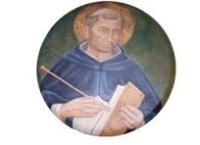
Feast day: 7 January
St Raymond of Penyafort was born on 6 January 1175 in Villafranca del Penèdes, a small town near Barcelona. He came from a noble family with connections to the House of Aragon. He was educated in Barcelona and the University of Bologna, where he received doctorates in both civil and canon law. From 1195 to 1210 he taught canon law. He moved to Bologna in 1210 where he remained till 1222, which included three years occupying the Chair of Canon Law. It was here he learned about the newly founded Dominican Order. He was attracted to it by the preaching of Blessed Reginald, Prior of the Dominicans in Barcelona and received the habit at the age of forty seven in the Dominican Convent of Barcelona.
Raymond was instrumental in the founding of the Mercedarian friars. When he was approached by Peter Nolasco, Raymond encouraged and assisted him in obtaining the consent of King James I of Aragon, for the foundation of the order. Their remit was to ransom Christian captives, who often suffered greatly in their imprisonment. The order was under the patronage of Our Lady of Mercy.
The General Chapter of the Dominican Order in Paris affirmed the need to study oriental languages. Raymond established the first school of the Studia Linguarum in Tunis, where it was known as Studium Arabicum. The objective of the schools was to help the Dominicans liberate Christian captives in Islamic lands.
Raymond wrote a book for confessors entitled Summa de casibus poenitentiae. It was a guideline for them and is widely considered an authorative work on the subject. In 1229 he was appointed theologian and penitentiary to the Cardinal Archbishop of Sabina, John of Abbeville. He was summoned to Rome in 1230 by Pope Gregory IX, who appointed him chaplain and grand penitentiary (confessor). He was then asked to codify canon law, writings of which had been scattered among many publications and were now to be organised in one set of documents. The Pope was pleased with Raymond’s work and commanded that it alone should be regarded as authorative. The collection of canon law, known as the Decretals of Gregory IX, became standard for seven hundred years. Canon Law was finally codified in 1917.
Raymond served as a confessor for King James of Aragon. The King went to the island of Majorca in an attempt to convert the Moors but he brought his mistress with him. Raymond, having failed to persuade the king to give her up, attempted to leave the island. The king prevented him from leaving by threatening ships’ captains with punishment if they took Raymond on board. Raymond, however, made a boat out of his cloak, using his staff as a mast. He then sailed the 160 miles to Barcelona in six hours. The spectacle was watched by a crowd of amazed spectators. King James mended his ways.
When he was sixty, Raymond became a recluse in Barcelona. He refused the office of Archbishop of Tarragona but was soon elected Master of the Order of Preachers by the General Chapter in 1238. He immediately set out of foot to visit the friars and nuns of the order. He also drafted new Constitutions of the Order which included a resignation clause for the Master. When it was adopted by the next General Chapter in 1240, he resigned after two years.
He was often consulted on the practices of the Inquisition in King James’ domains but with a sense of justice and compassion, avoiding the excesses of that institution. He also encouraged conjugal visits for prisoners, so that the spouses would not be tempted to adultery.
He worked for the conversion of the Moors, encouraging Thomas Aquinas to write his work Against the Gentiles. He introduced the teaching of Arabic and Hebrew into several Dominican houses. He also founded priories in Murcia (still ruled by the Arabs) and in Tunis. He also went on to help establish the Church in the recently-conquered island of Majorca.
He had great influence on King James and persuaded him to organise a debate between a Rabbi and a baptized Jew. It was held in the presence of the King and many of the higher clergy. The Rabbi was given perfect freedom of speech. On the Jewish Sabbath, at the close of the debate, the King and many of the clery visited the synagogue.
Raymond died at the age of one hundred in 1275 in Barcelona. He was canonized in 1601 by Pope Clement VIII. He was buried in the cathedral of Santa Eulalia in Barcelona.
St Raymond of Penyafort, pray for us.